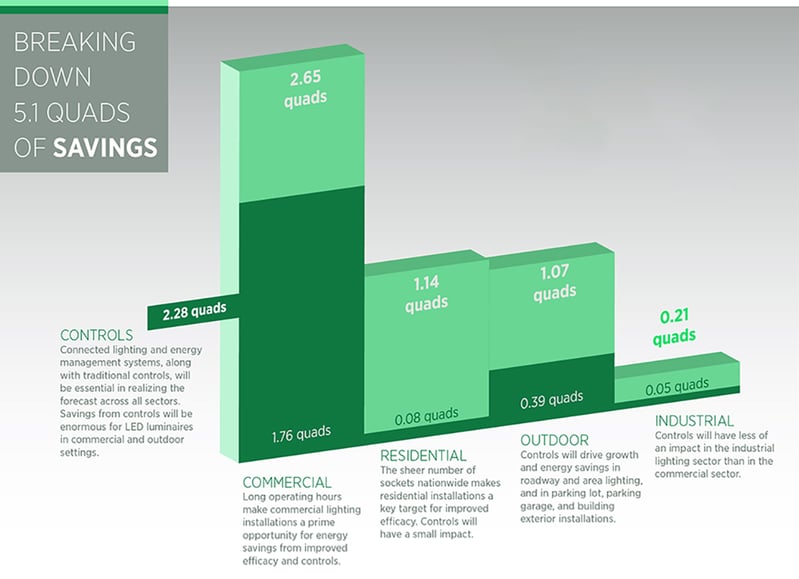Click To View
LED Benefit
Longer Lifetimes
For property owners and companies looking at long term efficiencies, adopting state-of-the-art technology like LED lights can produce greater cost savings. One of the most significant benefits of installing LED lighting when compared to traditional lighting systems is its long lifetime. When describing a commercial LED light lifetime, it’s often referred to by the number of operating hours until it is emitting 70 percent of its initial light output (L70). According to the Department of Energy, quality LEDs as an industry standard (white light used as a baseline) are designed to perform for an average of 50,000 hours or more. Compare that to the 1,000 hours typically gained from incandescent, 8,000 to 10,000 hours for compact fluorescent, and up to 30,000 hours from the most efficient linear fluorescent lights.
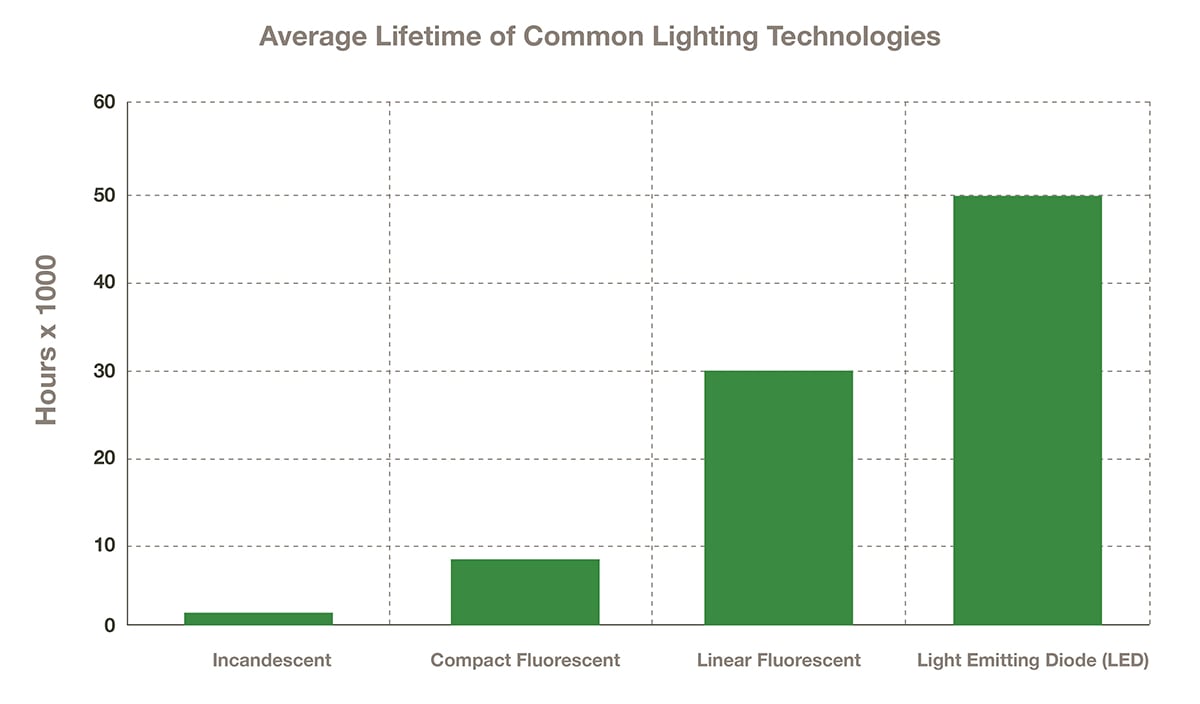
Since LEDs last 2-4 times longer than other outdated lighting like fluorescents, it means that maintenance associated with replacements is all but eliminated. It’s also worth noting that LED drivers used with LED lights have improved over time to last longer than conventional fluorescent lighting ballasts, which reduces replacement costs even further.
Lower Energy Costs
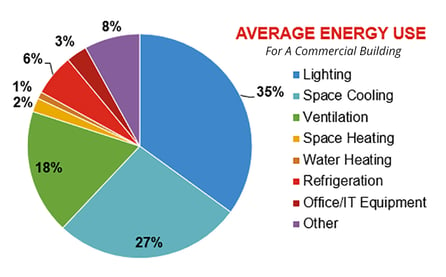
An average commercial building uses about 35 percent of its energy use on lighting alone.
The total energy costs saved will vary based on several factors, including number of lights, hours of usage, desired lighting levels, and local rates. An average commercial building uses about 35 percent of its monthly energy use on lighting alone. With that being substantial portion of energy use, what would reducing that cost substantially do for your bottom line? By having a professional assessment completed by a lighting expert you’ll be able to see a ROI customized specifically for your property.
Lower Maintenance
Ron Farmer, CEO of US LED, discusses LED lighting innovation and its longevity on Texas Business Radio. Video courtesy of RREA Media.
Environmentally Friendly
With organizations implementing green initiatives to make a positive impact on the environment, LED lighting is a green technology that can also help companies save money in the process. Although environmental issues aren’t associated with maximizing business profits, LED lighting helps contribute to lowering a carbon footprint while contributing to the bottom line. Unlike fluorescent lamps that produce a great deal of wasted heat, LEDs focus energy into visible light with little to no heat. This means less time for air conditioning to run and less energy consumption related to HVAC costs.
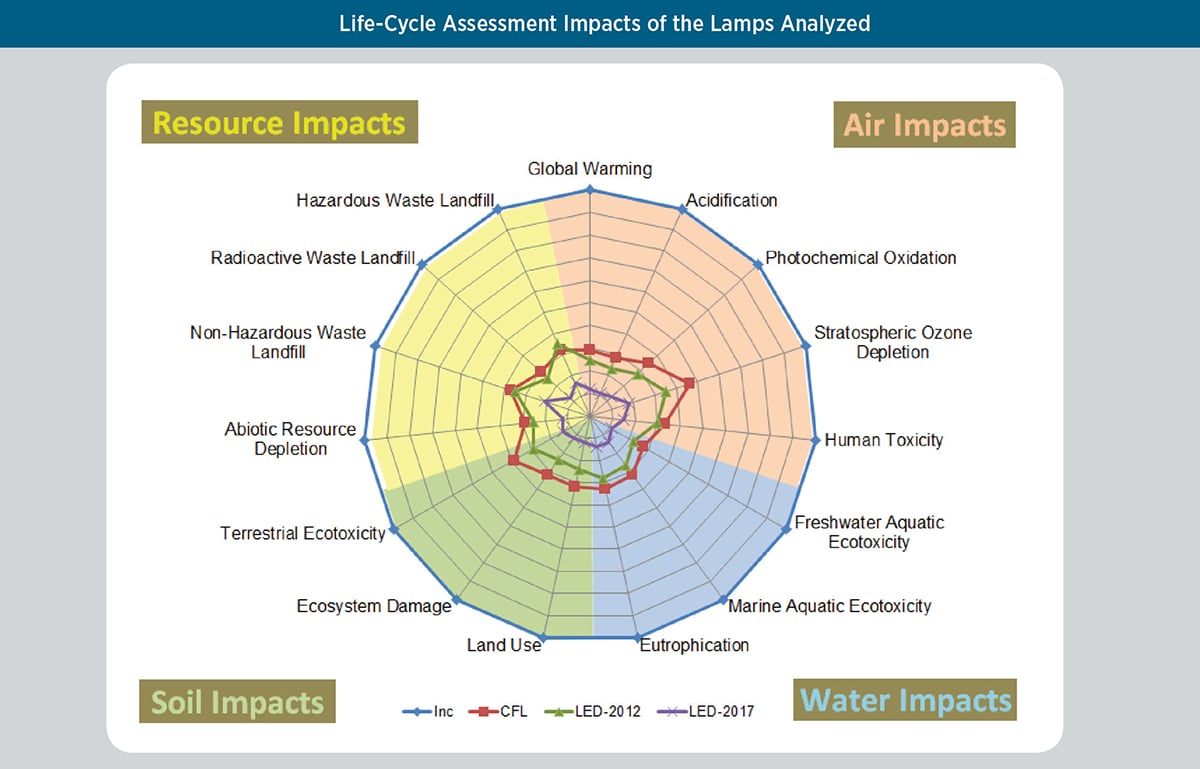
According to an US DOE assessment of the environmental impact of lighting technology, key findings indicated that LEDs had a significantly lower environmental impact than other lighting technologies.
Conventional fluorescent lamps must be handled with care and disposed of appropriately in order to avoid toxic materials, like mercury, from contaminating landfills or other public areas. A fact sheet on CFLs from the US Environmental Protection Agency notes that, “Exposure to mercury, a toxic metal, can affect our brain, spinal cord, kidneys and liver, causing symptoms such as trembling hands, memory loss, and difficulty moving.” By utilizing commercial or industrial LED lights, recycling programs can be eliminated and effectively reduce overhead costs associated with them. Consequently, less pollution is generated (like from a coal or gas-powered plant) when using LED lights as an alternative to fluorescent fixtures.
Safe and Secure Environments
Lighting is a critical component of safe environments for both employees and visitors alike. The way people work now has evolved and so should your lighting. Providing the appropriate light levels as determined by the Illuminating Engineering Society Standards is top priority for any organization to ensure wellbeing and deter crime.
Parking Lots
When employees are working hours outside of traditional daylight, it’s imperative that parking lots are lit with enough coverage for adequate visibility. Regardless of presence of security guards for escort, proper LED lighting relieves anxiety by reducing accidents, deterring criminal activity, and creates an inviting experience.
Parking Garages
Because of their closed off structures and isolation from main buildings, parking garages are another place energy-efficient LED lights are most necessary. When considering an upgrade, take into account that more than 10 percent of property crimes take place in parking lots or parking garages, according to the U.S. Bureau of Justice Statistics.
Schools and Office Buildings
Regardless if someone oversees an office or a school facility, safety is of paramount importance for both employees and visitors on the property. Proper parking lot lighting and lighting in remote locations of the property allow a great sense of security and better visibility to avoid accidents. With LED lights lasting longer, custodial staff won’t be dedicated to replacement problems and the challenges of dark areas going unnoticed will be resolved.
Industrial and Manufacturing Areas
Industrial and manufacturing environments need robust LED lighting solutions that improve illumination, minimize maintenance, and most of all improve safety. High bay LED lights easily illuminate large production areas and allows workers to better see the task at hand. With improved visibility, productivity will increase while accidents decrease.
Eliminate Dark Areas
No Delays When Starting Up
Do you find it annoying that there’s a slight delay in turning on the lights at your company? Aside from the initial flickering, fluorescent and HID lamps will not provide full illumination as soon as they are turned on. Most require up to five minutes or more to even reach their maximum output. LED lighting instantly comes on at 100-percent output and with no re-strike delay. Since time is money, this is an advantage to properties following a power outage or starting the day early in the morning when it’s still dark outside. Additionally, there’s a mental aspect to lights turning on immediately. When lights turn on immediately at full potential, it improves employee morale, increases productivity, decreases accidents, and showcases your brand in the best light possible.
Flexible Design
Here are just a few more benefits defined by the US Department of Energy:
- Provide apparent cooling or warming to a room. This can create psychological effects – for example, by using cooler-colored light to make occupants feel cooler on a sweltering summer day, or the reverse.
- Match room finishes, especially when they change on a seasonal basis, or when a space undergoes an interior-design remodeling or a branding/theme change.
- Suit the preferences of a new tenant, owner, or user.
- Simulate daylight or candlelight to set a mood, or match gallery lighting to the works of art on display.
- Match the color of daylight in a windowed lobby by, for example, tuning the light to be warmer during early morning and late afternoon and cooler at mid-day.
- Assist with behavior control. Some classroom studies suggest that the color and intensity of light can be modified to calm or invigorate students, or to focus their attention.
- Support the human circadian system. Light plays a key role in setting and regulating the body’s biological clock. Both the intensity and the spectral content of light can be used to stimulate or suppress the secretion of melatonin and other hormones that in turn affect our mood, alertness, and health. Although the exact mechanisms and effects are not yet fully understood, this may be an important consideration for industrial and medical spaces as well as senior- living facilities, prisons, dormitories, and high-density housing.
Understanding Color-Tunable Products From The Department of Energy. Video courtesy of the Office of Energy Efficiency & Renewable Energy.
Businesses can also take advantage of signage illuminated by LED modules for marketing purposes. An LED-illuminated sign can be customized for specific branding and uniquely fabricated to fit best on the property. This allows customers to find your business more effectively and showcases your organization in the best light.
Adjusting Color Temperature (CCT)
The way people work now has evolved and so has LED lighting technology. Offering the capability for occupants to adjust the color temperature of their lighting can help support how they work, improve productivity, and promote the ideal interior design theme.
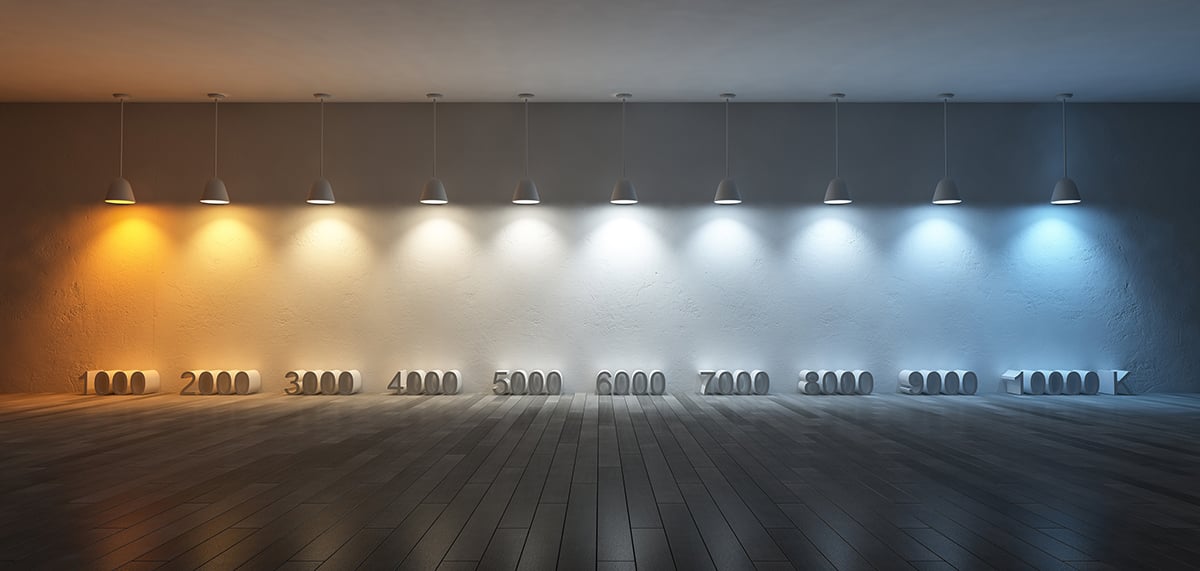
One of the advantages of adjustable color temperature is the affect it has on health. According to the International WELL Building Institute, Circadian Lighting Design is intended to provide users with appropriate exposure to lighting for maintaining circadian health and aligning the circadian rhythm with the day-night cycle. In an excerpt from the WELL Building Standard, the IWBI dives further into how light further affects the human body:
"Light is one of the main drivers of the circadian system, which starts in the brain and regulates physiological rhythms throughout the body’s tissues and organs, affecting hormone levels and the sleep-wake cycle. Circadian rhythms are kept in sync by various cues, including light which the body responds to in a way facilitated by intrinsically photosensitive retinal ganglion cells (ipRGCs): the eyes’ non-image- forming photoreceptors. Through ipRGCs, lights of high frequency and intensity promote alertness, while the lack of this stimulus signals the body to reduce energy expenditure and prepare for rest."
No Upfront Investment Needed
Why spend money on lighting when you can use it for something with better leverage? For companies looking to increase efficiencies, LED lighting can reduce your overall energy consumption and eliminate maintenance. Lighting as a Service is an all-inclusive subscription that allows business owners the ability to install energy-efficient LED lighting with no upfront capital. Monthly payments divide the cost of the new LED lighting, the initial installation, and the ongoing maintenance.

Lighting as a Service helps to create a reduction in energy usage and simultaneously cuts down lighting maintenance by installing new LED lighting at no up-front capital to end users. Because the Lighting as a Service is defined as a service agreement, it’s defined as an operating expense and not a capital expense on the books. Cash-flow is positive day one compared to other traditional procurement methods and the energy savings help pay for the program.
Safely Operate With No IR or UV Emissions
With less than 10 percent of the power used by incandescent lamp converting to visible light, most of the power is converted to infrared (IR) or radiated heat. Excessive heat or ultraviolet radiation (UV) creates a risk of accidental fire or burn to the environment the lights are in. Because of advancements in LED lighting technology, LEDs emit virtually no IR or UV. LED lights can safely and reliably illuminate UV sensitive items like artwork or food, which have potential risk of degrading over time if exposed to this type of emission long term. Unlike incandescent and fluorescent lighting, LEDs can operate in a wide range of temperatures without significant degradation and are easy to the touch even after running for long hours. Additionally, because LED lighting consumes less power than their legacy counterparts, they can operate effectively on low-voltage electrical systems. These are generally much safer if a failure occurs on site.
Controllability and Connectivity
The days of building occupants walking around to turn off lights at the end of the day are coming to an end now that LED lights are becoming networked and controlled. New LED lighting technology has enabled lights to be dimmed to 10 percent of light output while other fluorescent lights only reach 30 percent of full brightness. Another benefit of LED lighting is the continuous dimming, where the shift from 100 to 10 percent light output is smooth and seamless (not tiered). Pairing LED lighting with intelligent sensors can help build smarter buildings that have reduced energy consumption and more productive environments for the occupants. As the Internet of Things (IoT) enables people to connect a wide variety of items via the web, LED lights can be controlled digitally by precise amounts and get real-time reporting of how a building’s systems are performing. According to the U.S. Department of Energy’s Solid State Lighting Forecast Report, between the year 2015 and 2035, a cumulative energy savings of 62 quads (62 quadrillion BTUs) will be possible if the DOE’s goals for connected lighting and efficient LEDs are realized.

